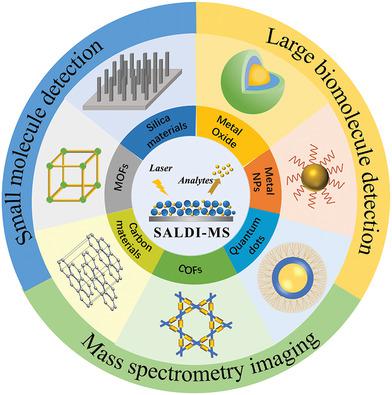当前位置:
X-MOL 学术
›
Small Methods
›
论文详情
Our official English website, www.x-mol.net, welcomes your feedback! (Note: you will need to create a separate account there.)
Nanostructured Substrates as Matrices for Surface Assisted Laser Desorption/Ionization Mass Spectrometry: A Progress Report from Material Research to Biomedical Applications
Small Methods ( IF 12.4 ) Pub Date : 2021-09-06 , DOI: 10.1002/smtd.202100762 Wen Ma 1 , Jun Li 1 , Xianjiang Li 2 , Yu Bai 3 , Huwei Liu 3
Small Methods ( IF 12.4 ) Pub Date : 2021-09-06 , DOI: 10.1002/smtd.202100762 Wen Ma 1 , Jun Li 1 , Xianjiang Li 2 , Yu Bai 3 , Huwei Liu 3
Affiliation

|
Within the past two decades, the escalation of research output in nanotechnology fields has boosted the development of novel nanoparticles and nanostructured substrates for use as matrices in surface assisted laser desorption/ionization mass spectrometry (SALDI-MS). The application of nanomaterials as matrices, rather than organic matrices, offers remarkable characteristics that allow the analysis of small molecules with fewer matrix interfering peaks, and share higher detection sensitivity, specificity, and reproducibility. The technological advancement of SALDI-MS has in turn, propelled the application of the analytical technique in the field of biomedical analysis. In this review, the properties and fabrication methods of nanostructured substrates in SALDI-MS such as metallic-, carbon-, and silicon-based nanostructures, quantum dots, metal-organic frameworks, and covalent-organic frameworks are described. Additionally, the latest progress (most within 5 years) of biomedical applications in small molecule, large biomolecule, and MS imaging analysis including metabolite profiling, drug monitoring, bacteria identification, disease diagnosis, and therapeutic evaluation are demonstrated. Key parameters that govern nanomaterial's SALDI efficiency in biomolecule analysis are also discussed. Finally, perspectives of the future development are given to provide a better advancement and promote practical application in clinical MS.
中文翻译:

纳米结构基板作为表面辅助激光解吸/电离质谱的基质:从材料研究到生物医学应用的进展报告
在过去的二十年里,纳米技术领域研究成果的升级促进了新型纳米颗粒和纳米结构基底的开发,这些基底用作表面辅助激光解吸/电离质谱 (SALDI-MS) 的基质。纳米材料作为基质而不是有机基质的应用提供了显着的特性,可以分析具有较少基质干扰峰的小分子,并具有更高的检测灵敏度、特异性和重现性。SALDI-MS 的技术进步反过来又推动了分析技术在生物医学分析领域的应用。在这篇综述中,SALDI-MS 中纳米结构基底的特性和制造方法,如金属、碳和硅基纳米结构、量子点、描述了金属有机框架和共价有机框架。此外,还展示了生物医学应用在小分子、大生物分子和 MS 成像分析(包括代谢物分析、药物监测、细菌鉴定、疾病诊断和治疗评估)方面的最新进展(大多数在 5 年内)。还讨论了控制纳米材料在生物分子分析中的 SALDI 效率的关键参数。最后,展望了未来的发展前景,以提供更好的进展并促进临床 MS 的实际应用。证明了细菌鉴定、疾病诊断和治疗评估。还讨论了控制纳米材料在生物分子分析中的 SALDI 效率的关键参数。最后,展望了未来的发展前景,以提供更好的进展并促进临床 MS 的实际应用。证明了细菌鉴定、疾病诊断和治疗评估。还讨论了控制纳米材料在生物分子分析中的 SALDI 效率的关键参数。最后,展望了未来的发展前景,以提供更好的进展并促进临床 MS 的实际应用。
更新日期:2021-10-28
中文翻译:

纳米结构基板作为表面辅助激光解吸/电离质谱的基质:从材料研究到生物医学应用的进展报告
在过去的二十年里,纳米技术领域研究成果的升级促进了新型纳米颗粒和纳米结构基底的开发,这些基底用作表面辅助激光解吸/电离质谱 (SALDI-MS) 的基质。纳米材料作为基质而不是有机基质的应用提供了显着的特性,可以分析具有较少基质干扰峰的小分子,并具有更高的检测灵敏度、特异性和重现性。SALDI-MS 的技术进步反过来又推动了分析技术在生物医学分析领域的应用。在这篇综述中,SALDI-MS 中纳米结构基底的特性和制造方法,如金属、碳和硅基纳米结构、量子点、描述了金属有机框架和共价有机框架。此外,还展示了生物医学应用在小分子、大生物分子和 MS 成像分析(包括代谢物分析、药物监测、细菌鉴定、疾病诊断和治疗评估)方面的最新进展(大多数在 5 年内)。还讨论了控制纳米材料在生物分子分析中的 SALDI 效率的关键参数。最后,展望了未来的发展前景,以提供更好的进展并促进临床 MS 的实际应用。证明了细菌鉴定、疾病诊断和治疗评估。还讨论了控制纳米材料在生物分子分析中的 SALDI 效率的关键参数。最后,展望了未来的发展前景,以提供更好的进展并促进临床 MS 的实际应用。证明了细菌鉴定、疾病诊断和治疗评估。还讨论了控制纳米材料在生物分子分析中的 SALDI 效率的关键参数。最后,展望了未来的发展前景,以提供更好的进展并促进临床 MS 的实际应用。



























 京公网安备 11010802027423号
京公网安备 11010802027423号